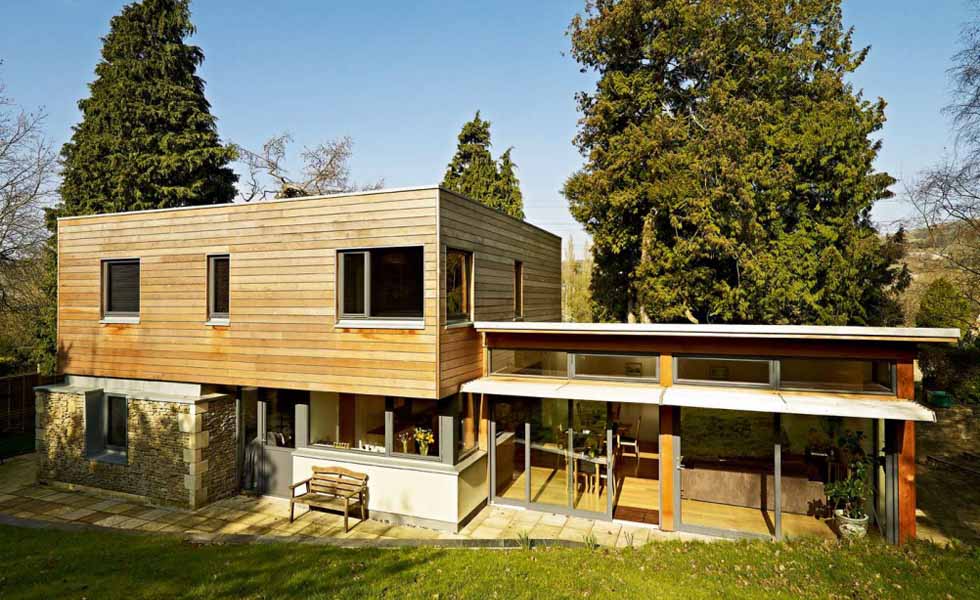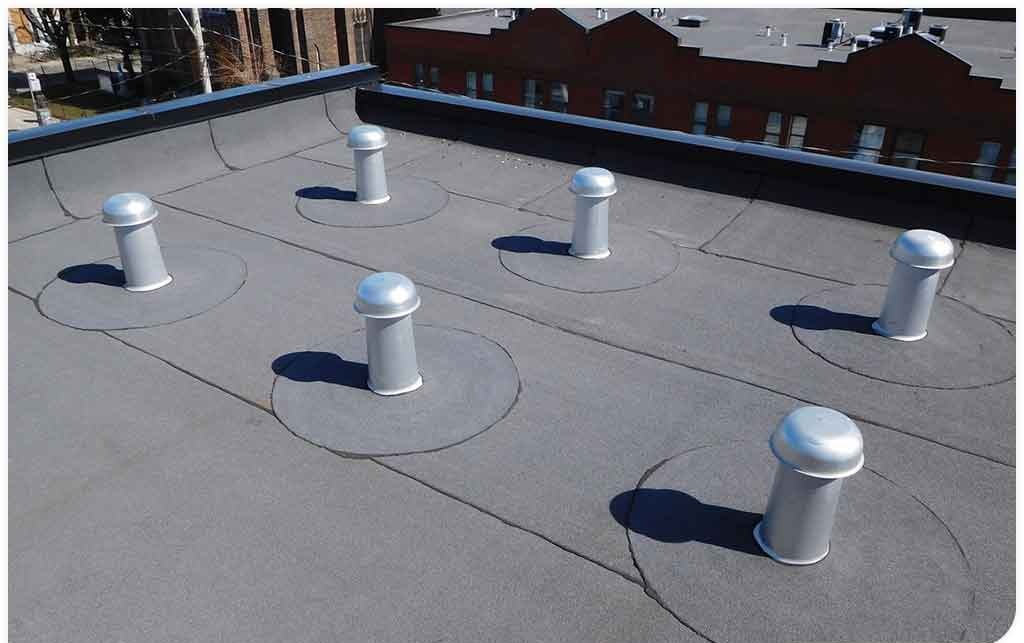Choosing a flat roof
Once an architect determines the desire, or need, for a flat roof, identifying the correct solution can be a complex process. A range of factors have to be taken into account including length of guarantee, the supporting structure, impacts on BREEAM ratings, build sequencing, aesthetics and cost.
Of course, along with the client and architect’s requirements the compliance minefield of British building standards and codes of practice has to be negotiated. Although architects are primarily concerned with design, their remit in selecting a roofing system is usually a combination of design criteria, performance requirements and cost.
There are four primary types of flat roof commonly used in the UK, each with their advantages and disadvantages. Of course an architect does not need a detailed understanding of every type of flat roof. However, a basic understanding of these four major systems will allow architects to make a well-informed decision – especially as sometimes the solution offered by an individual manufacturer may not be the best for the requirements of your particular project.
Single ply
A single ply membrane system provides waterproofing with a single sheet of roofing material. Managed and regulated by the Single Ply Roofing Association (SPRA), this is a well established and proven technology that has been used in the UK for over 50 years.
Single ply roofs are often considered for cost driven projects as they have a low capital cost and cost in use, are lightweight, flexible, swift to install, safe and available in any colour. These attributes make them an extremely popular choice for both cold and warm roofs, refurbishment and new build, with over 5 million m2 installed in the UK every year. Single ply roofs provide an ideal surface for subsequent photovoltaic systems and, as long as the product chosen is FLL certified, can also be used with a green roof.

Choosing the Best Option For A Flat Roof
Torch on Felt
Felt roofing came about as an improvement on the previous mineral felt roofing used in the 1960s and 1970s. The previous technique involved hot bitumen and mineral felt being poured onto a roof and rolled flat. This left an unattractive finish with a shorter lifespan of about 10 years. These roofs were easily damaged by stones under the membrane causing punctures. The new system allows the material to be peeled off and stuck to the surface of the roof, producing a finished product that is simple and affordable
EPDM Rubber Roof
Introduced to the UK market several years ago, these roofs have become increasingly popular. Made up of a rubber compound, this material is single ply and installed in one complete layer. The layer is glued to the decking of the roof using a strong adhesive
Fiberglass
Normally laid in one or two layers with a smooth finish and completed with factory made trims. The system is laid on timber boards that are glued at the joints. The whole decking is laid with a glass fibre matting and a base coat of fibre resin, and completed with a top coat of resin
Flat Roofs: A Handy Guide
Flat roofs are exceedingly popular with those looking to create a cool, modern home. Flat roof options help to free up internal space and are often cheaper that pitched roof options as they require fewer materials to cover the same roof span. There is also the scope to incorporate a green roof onto the flat structure.
What Pitch is a Flat Roof?
If flat roofs are to work well, they have to have a slope, known as a fall, to shed rainwater. The fall should never be less than 1:80 and preferably about 1:40.
There are several methods of building in a fall:
One is to set the cross walls at different heights. Most people shy away from this because they don’t like the idea of having an internal ceiling that slopes
A far more common method is to use ‘firring strips’, which are battens cut at an angle and placed on top of the roof joists
Another possibility is to cut a fall into the roof insulation, something several businesses now offer — it’s often referred to as tapered insulation
How exactly a fall is built in largely depends on how the flat roof is built. There are three main choices:
The cheapest and simplest solution is to construct a warm roof. This is where the roof insulation sits directly on top of the timber structure (thus keeping it warm) and then the roofing membrane is laid over the insulation
A cold roof places the insulation between the rafters, underneath the ply roof covering. It is the standard method employed on flat-roofed extensions but it is rarely used for new builds today. In general, a warm roof is preferable from a construction angle, but it does lead to a higher roof profile, which isn’t always acceptable from a planning perspective
There a number of variations of the warm roof, referred to as hybrid roofs, which introduce different elements. In particular, some designs call for a ventilation gap above a warm roof in order to eliminate any possibility of moisture build-up inside the roof structure
Flat Roof Coverings
Over the years many products have been used and none has emerged clearly as the best. In practice most people plump for the system their installer or designer likes the most. Generally speaking, the issues to watch are the cost and the guarantee offered. As a rule, don’t go for anything less than 20 years
SAGE TIPS FOR SELECTING A REPLACEMENT FLAT ROOF
The road to flat roof selection can be a bumpy one. The process may seem simple, but it is surprisingly complicated. Considering that a low-slope roofing system does not drain quickly and is more prone to leakage, you have to put extra attention to every decision you have to make.
Understand All of Your Options
As with pitched roofing, flat roofing has an abundance of material options. Generally, there are two product categories: asphalt-based systems and single-ply systems.
The first group involves building up layers of hot or cold asphalt sandwiched by fiberglass or modified rolls. Gravel or asphalt-based granulated cap sheet accounts for the top-most portion. The installation is often messy because of all of the work necessary to apply the materials.
Think About Maintenance
Make sure that the design of your flat roof is maintainable. Otherwise, it would be difficult to carry out snow removal and any other activity related to the upkeep of your low-slope roofing system properly, efficiently, and safely
Put a Premium on Protection
Superior roofing warranties will give more bang for your buck. Ask about covered components, conditions, and limitations, and coverage periods.

Which flat roof system is best?
the most appropriate flat roofing system really comes down to 2 questions:
will there be cooking in the building? If so, go with PVC since it’s resistant to fire, fat, and grease.
if there won’t be any cooking, is money a concern?
if money is a concern, go with EPDM or Modified Bitumen as these are your least expensive flat roofing systems.
if money isn’t an issue, choose TPO since it’s still strong but less expensive than PVC.
Also see related article Which roofing material is right for you.
What is a flat roof? What qualifies as a ‘flat’ roof?
A flat roof is a roof that, well, looks flat. It’s not really flat, however. It’s a roof whose pitch, or angle, is less than 2/12, or 9.5º. (2/12 means for every 12″ of horizontal length, the roof rises 2″ in height.)
What are your flat roof options?
Although there are several flat roof systems available today, in this article, we’re only going to cover the systems we offer
Cost
For most businesses, the cost of a commercial roof is the first consideration; which commercial roofing system is the least expensive, not only to purchase, but to install, maintain, and repair. Cost should not be your only consideration, however
Cooking
Really, the first question on everyone’s mind when choosing a flat roofing system should be whether there will be a lot of cooking in the building. If there will be, because you own a restaurant or a hospital, you should use PVC because it is resistant to fats and greases and fire. If you just focused on cost and put an EPDM roof on your restaurant, the grease that gets sucked-up through your ventilation will be deposited onto your roof and that EPDM roof will breakdown quickly, costing you more money in the long run.